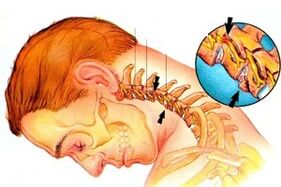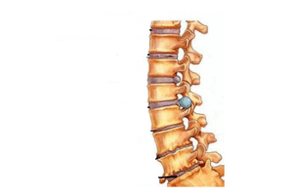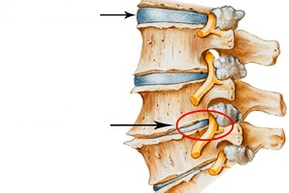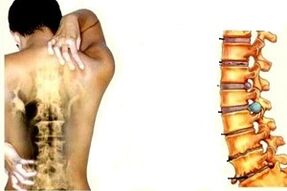
Diseases of the musculoskeletal system are one of the most common diseases on earth.Few people have been able to avoid them altogether, especially after 40 years, although experts acknowledge that spinal, muscle and joint problems are “young” and very young people are increasingly complaining about pain.
This mistake is the way lifestyle has become familiar: inactive, long staying in a position (usually after gadgets and monitors) lack of physical exercise.As a result, posture is disturbed, salt and other harmful substances accumulate in the body, and the function of the musculoskeletal system is damaged, so internal organs may be deformed.
In most cases, osteochondrosis is due to the disease found, and people are affected by older and quite young diseases, as well as osteochondrosis problems in the lumbar and cervical spine.The second most frequent type of osteochondrosis is an unpleasant disease, and in addition - a progressive disease is performed without treatment, and its lifestyle is severely aggravated with disability.This means it is necessary to identify the symptoms of the disease in a timely manner and contact an orthopedic or transgender doctor for treatment in a timely manner.
How cervical osteochondrosis develops
If a person lives a sedentary lifestyle, or has a profession that has been around for a long time, the risk of encountering osteochondrosis is high.As the disease progresses, the discs change, and they deform and change their structure.
The intervertebral disc is located between the vertebrae and its task is to keep the spine so that it is flexible and durable.There are seven vertebrae on the neck, and with the help of supporting and rotating the head, the neck, etc. are bent.The cervical spines are very close to each other, so they are injured and transferred from mild physical fatigue.The danger of disease is that the nerve ends of the spinal nerves are affected, so the blood vessels that supply the brain and brain are affected.In turn, the brain does not receive important substances, which can lead to the development of many other more serious diseases that can lead to the patient's disability or even death.
Cervical osteochondrosis has many causes and developments.Among the most common and frequent reasons, the following can be distinguished:

- The metabolism in the body is impaired, especially in the cervical area, hormone imbalance;
- Salt deposition;
- Low physical activity, sedentary lifestyle;
- Stay in a position for a long time (on a computer, the steering wheel of the car, etc.);
- Improper nutrition;
- Too much weight;
- Neck injuries and bruises;
- Hypothermia.
Osteochondrosis also occurs in the context of chronic diseases of the musculoskeletal system, such as scoliosis or rheumatism.
In addition, osteochondrosis usually leads to genetic susceptibility to the human body.
But whatever the cause, osteocartilage degeneration must be treated immediately after its first symptoms appear.
Signs of cervical osteochondrosis
Osteochondropathy in this spine is not always dramatically unexpected.Most commonly, it develops slowly and over time, the symptoms will increase and its number will increase.The more damage to the vertebrae, the more obvious the signs are.
The first symptom that needs to be paid is pain with different strengths of the cervical spine, which is given to other parts of the body - head, forehead, ears, forearms, shoulders, shoulders, chest, etc.If pain occurs, consult your doctor to determine if it is really osteochondrosis, which is usually similar in symptoms of other diseases.
Other signs of osteochondrosis
- The pain in the neck is enhanced by the load or turn of the head.
- The patient feels numb, burning or tingling in the limbs;
- For headache, dizziness, weakness, patients may complain about darkening eyes, spots, and tinnitus;
- If you turn your head suddenly, you may faint.
Cervical osteochondrosis has the following characteristics:
- Lack of coordination;
- Pain in the heart area;
- Vision and hearing worsen.
Types of osteochondrosis
Doctors distinguish several syndromes according to the type of stressed nerve and the nature of the disease:
- nerve root syndrome;
- vertebral artery syndrome;
- Heart syndrome.
The nerve root syndrome is the first squeeze on the cervical nerve endings.The neck feels pain and radiates to the scapula, lower back, shoulders and forearms.
Patients with vertebral artery syndrome will experience pulsating pain in the back of the head or temples, or burning pain in the neck and back of the head, which will aggravate when turning heads, sleeping, coughing, and radiate to the chest and shoulders.
For cardiac syndrome, the symptoms initially resemble angina, but the pain does not go away after taking nitroglycerin, lasts for hours and is exacerbated with exercise and deep breathing.
Symptoms of damage to specific vertebrae
Treatment of osteochondrosis based on damage to nerve endings.There are only eight of them, each above the cervical vertebrae.It is possible to determine which vertebrae are hit by symptoms that correspond to certain nerves in the spine.
Neurological outcomes and impairment of characteristic pain

- Department 1 and Department 2: Sensitivity of the head and back, pain in the parietal lobe and occipital area is broken;
- The third department: numbness in the neck, language disorders, language sensitivity; it rarely occurs.
- Fourth department: pain and numbness in the clavicle and/or shoulders, invasion of the respiratory system, heartache;
- Part 5: Shoulder pain, pain on the outer surface of the shoulder, impaired sensitivity of the limbs;
- The sixth and seventh departments: pain in the neck, blade, forearm, back, lower back, impaired sensitivity of hands, fingers; the most common failure;
- Department 8: pain in the neck, back, elbow, numbness in all the limbs, blue color of legs and brushes caused by blood circulation diseases, lack of skin sensitivity, and impart it to the legs.
Diagnosing and treating cervical osteochondrosis

In order to reliably determine the diagnosis of "cervical bone and chondropathy", you must consult a doctor.Many of the symptoms of osteochondrosis are similar to signs of other diseases, so not only do they begin treatment for osteochondrosis, but they also do not miss other pathology.
If osteochondrosis and fabricated signs of nerve ends are suspected, doctors prescribe radiography, with data failure calculations or magnetic resonance tomography, extra multi-position and duplex scanning for ultrasound.
Based on these studies, the nature of pain syndrome and other symptoms in general, you can determine which discs are damaged and start the necessary treatments that will restore the affected vertebrae and nerve roots and will not allow complications of osteochondrosis.
Treatment is prescribed by a doctor and is usually complicated.First, it should relieve pain symptoms, which are sometimes actually unbearable and can not only be tolerated, but also spread not only around the neck but also to other parts of the body.
To do this, use painkillers in tablets, but in case of excessive and severe pain, non-replacement anti-inflammatory drugs as well as warming and painkillers are indicated.
Because medications and ointments can only relieve pain and other symptoms of osteochondrosis in the neck, but will not get rid of its causes.After reducing the sensation of pain, the patient is prescribed massage, physical therapy and physical therapy.Patients show diet, diets that improve blood circulation and support human function, tablets and injections, as well as cartilage protectors that help protect and restore intervertebral disc fabrics.
In some cases, the bathroom, paraffin application, reflexology, and Hirudotherapy prescribe for additional treatments for the patient.Folk methods for treating cervical osteochondrosis often help to restore the patient’s usual lifestyle as well, but should only be used in conjunction with traditional methods and after consulting a doctor, as traditional medicine can cause contraindications and the use of prescriptions can damage the body so weakened.
Complications and prevention of diseases

Don’t forget: the treatment of cervical osteochondrosis should be initiated as soon as possible.The longer you go to the doctor, the harder it is to cure the disease, and at the same time, it can cause various complications.Osteochondrosis in the cervical spine is very dangerous because in this section there are many blood vessels and nerve plexuses that can feed the brain.
Any violation can cause problems with brain circulation, neurological diseases (including migraines and high blood pressure) and can affect the heart, respiratory system, hearing, and vision.
If osteochondrosis is fired, more serious consequences may occur in the form of cerebral ischemia, spinal stroke, or radical disease, a disease that is a disease of the process of forming on the affected vertebrae that partially or completely deprives the body of sensitivity and mobility.But this is not the worst thing, because in severe osteocartilage, the spinal cord is compressed, which can lead to death of the patient.
Therefore, it is important to listen to your symptoms as soon as possible and turn to an expert who can help you get back to life.To avoid diseases like cervical osteochondrosis, you need to move more, don’t avoid physical exercise, monitor weight, eat properly, and stay balanced, and also visit an orthopedic doctor or vertebrologist regularly.
























